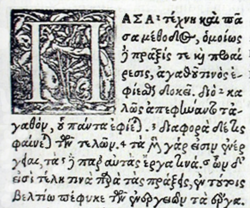
Back Ereadurioù gresianek Breton Griechisches Alphabet#Ligaturen German Ελληνικά τυπογραφικά συμπλέγματα Greek Ligatures de l'alphabet grec French Греческие лигатуры Russian
| Greek alphabet | ||||||||||||||||||||||||||||||||||||||||||||||||
|---|---|---|---|---|---|---|---|---|---|---|---|---|---|---|---|---|---|---|---|---|---|---|---|---|---|---|---|---|---|---|---|---|---|---|---|---|---|---|---|---|---|---|---|---|---|---|---|---|
|
||||||||||||||||||||||||||||||||||||||||||||||||
| History | ||||||||||||||||||||||||||||||||||||||||||||||||
|
||||||||||||||||||||||||||||||||||||||||||||||||
| Diacritics and other symbols | ||||||||||||||||||||||||||||||||||||||||||||||||
| Related topics | ||||||||||||||||||||||||||||||||||||||||||||||||

The sample shows the -os ligature in the middle of the second line (in the word μέθοδος), the kai ligature below it in the third line, and the -ou- ligature right below that in the fourth line, along many others.

Greek ligatures are graphic combinations of the letters of the Greek alphabet that were used in medieval handwritten Greek and in early printing. Ligatures were used in the cursive writing style and very extensively in later minuscule writing. There were dozens[1][2] of conventional ligatures. Some of them stood for frequent letter combinations, some for inflectional endings of words, and some were abbreviations of entire words.
- ^ The Philokalia Package Archived 2012-05-25 at the Wayback Machine, for LaTeX
- ^ Carl Faulmann, Das Buch der Schrift: Schriftzeichen und Alphabete aller Zeiten und Völker, Vienna 1880, p.172-176.